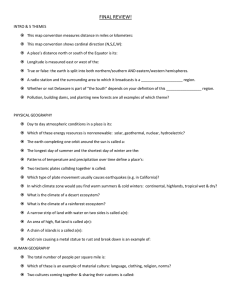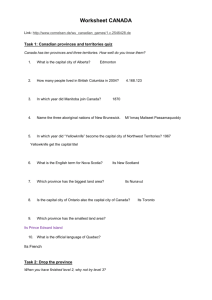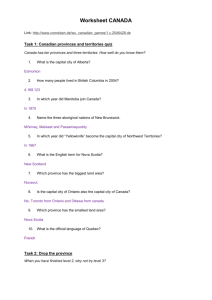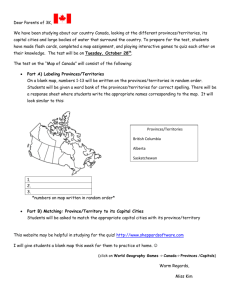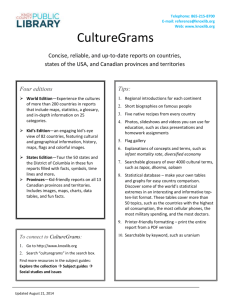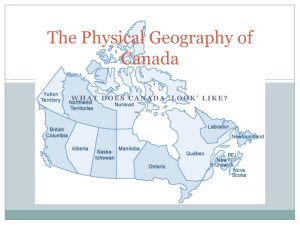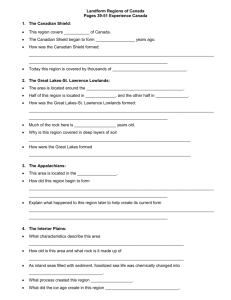Unit 1 test review
advertisement
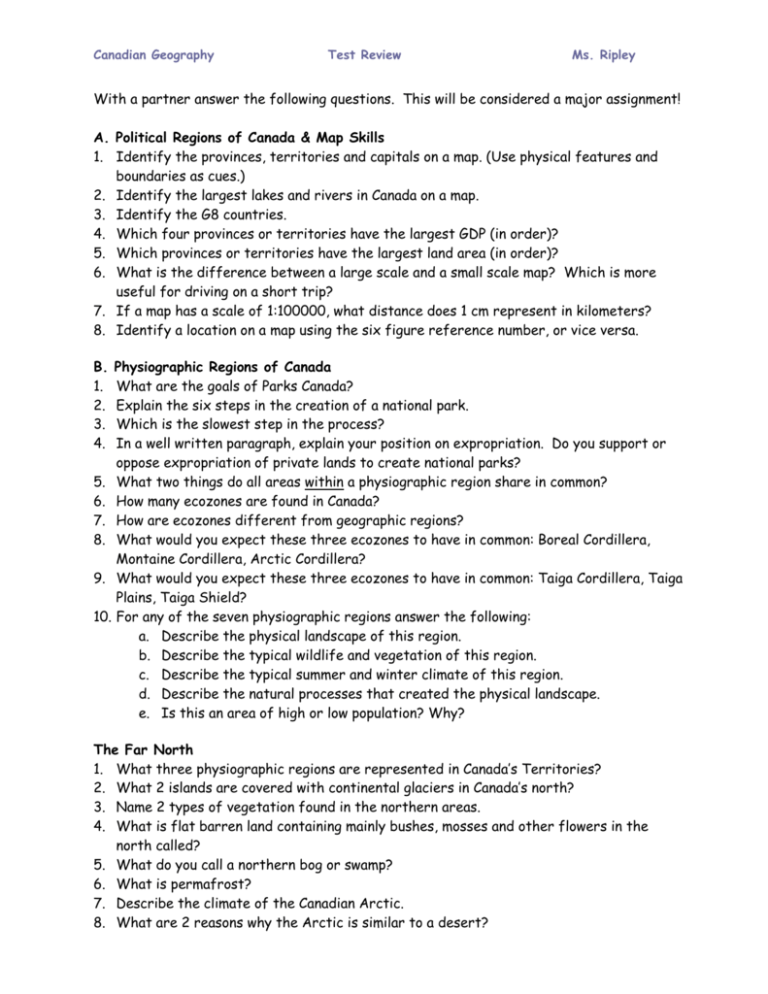
Canadian Geography Test Review Ms. Ripley With a partner answer the following questions. This will be considered a major assignment! A. Political Regions of Canada & Map Skills 1. Identify the provinces, territories and capitals on a map. (Use physical features and boundaries as cues.) 2. Identify the largest lakes and rivers in Canada on a map. 3. Identify the G8 countries. 4. Which four provinces or territories have the largest GDP (in order)? 5. Which provinces or territories have the largest land area (in order)? 6. What is the difference between a large scale and a small scale map? Which is more useful for driving on a short trip? 7. If a map has a scale of 1:100000, what distance does 1 cm represent in kilometers? 8. Identify a location on a map using the six figure reference number, or vice versa. B. 1. 2. 3. 4. Physiographic Regions of Canada What are the goals of Parks Canada? Explain the six steps in the creation of a national park. Which is the slowest step in the process? In a well written paragraph, explain your position on expropriation. Do you support or oppose expropriation of private lands to create national parks? 5. What two things do all areas within a physiographic region share in common? 6. How many ecozones are found in Canada? 7. How are ecozones different from geographic regions? 8. What would you expect these three ecozones to have in common: Boreal Cordillera, Montaine Cordillera, Arctic Cordillera? 9. What would you expect these three ecozones to have in common: Taiga Cordillera, Taiga Plains, Taiga Shield? 10. For any of the seven physiographic regions answer the following: a. Describe the physical landscape of this region. b. Describe the typical wildlife and vegetation of this region. c. Describe the typical summer and winter climate of this region. d. Describe the natural processes that created the physical landscape. e. Is this an area of high or low population? Why? The Far North 1. What three physiographic regions are represented in Canada’s Territories? 2. What 2 islands are covered with continental glaciers in Canada’s north? 3. Name 2 types of vegetation found in the northern areas. 4. What is flat barren land containing mainly bushes, mosses and other flowers in the north called? 5. What do you call a northern bog or swamp? 6. What is permafrost? 7. Describe the climate of the Canadian Arctic. 8. What are 2 reasons why the Arctic is similar to a desert? Canadian Geography Test Review Ms. Ripley 9. Approximately what percentage of Canada’s total area do the territories represent? 10. What is the name of the river that flows north to the Beaufort Sea? 11. Name the largest lake in Canada. Where is it found? 1. 2. 3. 4. 5. 6. 7. 8. The Canadian Cordillera Describe the differences in the climates of coastal BC and interior BC. Where is Canada’s highest point? What is the capital city of B.C.? What's the name of the Canadian west coast mountain system? Name the mountain range on the eastern boundary of B.C. What's the main cause of forest fires in BC? What's the longest river in B.C.? Name the type of forest which grows mainly in the west coast climate. 1. 2. 3. 4. 5. 6. 7. 8. 9. 10. 11. 12. The Great Plains Which province has all boundaries based on lines of latitude and longitude? Name the Prairie Provinces from east to west. Name the easternmost province in the Prairies. Name the westernmost province of the Prairies. Which city is further north: Calgary or Edmonton? What's the steady rise in elevation near the base of the Rockies in Alberta called? What part of the Prairies is not part of the Interior Plain? What is the unique landscape near Brooks and Drumheller, Alta. called? What natural forces create this landscape? What accounts for 9% of the area of the Prairies? What part of the Prairies has the highest elevation? Winnipeg is the capital city of what province? The Canadian Shield and Hudsons Bay Lowlands 1. Describe the typical wildlife and vegetation of this region (in either area). 2. What major cities are found here? 3. What human activities take place here? 1. 2. 3. 4. 5. 6. The Great Lakes – St. Lawrence Lowlands Identify the Great Lakes from west to east or east to west. Which of the Great Lakes has the biggest surface area? What is the difference in elevation between Montreal and Lake Superior? Which province has a greater percentage of Canada’s GDP than of population? Niagara Falls lies between which 2 lakes? What is the steep-cliffed area in southern Ontario called? The Appalachian Region 1. What provinces make up the Maritimes? 2. Which provinces are included in Atlantic Canada? Canadian Geography 3. 4. 5. 6. Test Review Which is further south, Fredericton or Yarmouth? The Northumberland Strait is between which two areas? Where are the highest lands of this region located? Where are the highest lands of Nova Scotia located? Ms. Ripley
